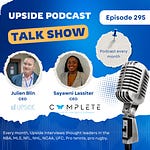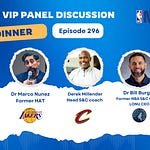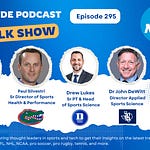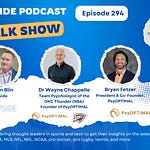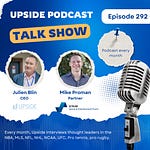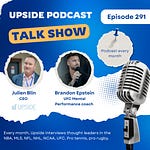Dear colleague,
This week I sat down with David Daoud, CEO of Compliance Standards to share my thoughts on the sports tech market, the various segments (Performance tech Vs fan engagement, AI), the latest trends, my favorite technologies, the average tech budgets by leagues (NBA, MLS, etc..), the sports leagues that are hard to break into and more.
You can listen to the audio interview by clicking on the above button or just watch the full video interview here. You can also check out the best quotes of my interview in the following section.
📝Show Notes: Through this interview, I touched on:
How I ended up working with professional teams.
The various segments of sports & Tech (Performance tech, fan engagement, AI..)
The average performance tech budgets per leagues (NBA, NFL, MLS..).
How hard it is to get to work with teams across certain leagues.
The future of the sports performance market and how AI is set to impact the space across various levels.
Best,
You can read the full transcript of the interview located at the top of this blog post. Here are below the best quotes from my interview:
Q1. How did you get started working in the world of elite sports?
"About 10 years ago, when I was living in San Jose, CA, I was working for big tech companies like Google and Samsung, but I always loved sports. I wanted to find a way to work with professional teams, but I had zero connections in the industry."
"So one night, I decided to take a chance—I sent an email to the president of the San Jose Earthquakes, an MLS team. The very next day, I got a response from their head athletic trainer. That one connection led to more conversations, and soon after, I was talking to teams like the Golden State Warriors (NBA), the San Francisco 49ers (NFL) and SJ Sharks (NHL)."
"I started building relationships, and over time, I connected with legends like Roger Craig (former NFL star), and through those connections, I kept expanding my network. Fast forward 10 years, and now I’ve built a global ecosystem of 7,000+ sports and tech executives. Today, I act as a kind of technology scout, recommending the best innovations to teams in the NBA, NFL, MLS, MLB, NCAA, pro rugby, pro tennis, and so on. I have built relationships with about a third of the NBA, MLS, MLB, NFL and NHL teams. I also have relationships with 14 NCAA teams. I also have build relationships with top teams in the Premier League, Laliga, as well as national soccer and rugby teams. I talk to new teams every week”.
"The key was persistence and adding value to the teams rather than just selling to them. Once I built credibility, teams started reaching out to me, asking for recommendations on new technologies to improve performance, injury prevention, and recovery."
Q2. What are the various segments of sports & tech?
"The sports tech market is massive, but it really depends on how you define and segment it. You have different categories, like performance technology, which includes GPS tracking, heart rate monitors, hydration assessment tools, and sleep trackers. Then you have athlete management systems (AMS), which allow teams to triangulate data like GPS, cardio, and recovery metrics."
"But there’s also a completely separate world of digital sports technology, which includes AR, VR, Web3, mobile apps, and social media platforms. This is a much larger market with significantly bigger budgets. Teams allocate millions of dollars annually to enhance the fan experience, improve ticketing, and build out digital infrastructure."
"When I talk to investors, I always tell them they need to understand these two separate ecosystems—performance tech and digital tech—because the budgets, buyers, and use cases are completely different."
Q3. What are the most popular types of technologies teams are investing in right now?
"Right now, load management and injury prevention technologies are a huge focus for teams. GPS tracking, HR monitoring systems, and AMS systems have become standard, but teams are looking for even more precise, actionable health insights about their players. That’s why we’re seeing a rise solutions (via wearables or tools using saliva analysis) that track hydration, cortisol, glucose, and lactate levels in real time. There is also a lot of interest towards video analysis tools and solutions that can help athletes improve their sleep".
"There’s also growing interest in cognitive training and reaction-time assessment tools. Teams are realizing that when players come back from injury—like an ACL tear—they focus on physical rehabilitation but often neglect cognitive recovery. New technologies using LiDAR technology and force plates are helping teams monitor both physical and cognitive performance in real time."
"In addition, concussion prevention is a major area of investment, especially in the NFL, NHL, and even soccer. Teams are looking at neck-strengthening devices collecting data or advanced helmets to help reduce concussion issues."
Q4. What are your favorite technologies for teams right now?
"One of my favorite innovations is a neck-strengthening device built by Kinmetrix to help reduce concussions. A stronger neck can help reduce concussion risk, and this is especially relevant for sports like football, hockey, rugby, and even soccer—where head impacts are common. This device is helping teams quantify neck strength and implement targeted training programs."
"One more that stands out is a saliva-based hydration test built by LogicInk. It’s an easy, cost-effective way to quickly measure hydration levels and dehydration risk in athletes. Compared to other methods, this is faster, more portable, and highly accurate."
Q5. How would you define sports medicine?
"Sports medicine is a broad field that integrates both hardware and software solutions. It includes wearable technology that tracks hydration, glucose, lactate, and other biomarkers, but also AI-driven software that takes this data and translates it into actionable health insights for teams."
"For example, a modern sports medicine system should be able to say, ‘Player A has a 70% higher risk of injury for the next game based on their fatigue and workload levels. Here’s what you should do now to prevent it.’ That’s where AI and Gen AI are making a huge difference—helping teams move from data collection to real-time decision-making."
"I tend to use the term sports performance rather than sports medicine, because it includes everything—GPS, sleep tracking, hydration monitoring, biomechanical assessment tools, rehabilitation technologies, and even robotic rehab tools."
Q6. What are the average performance tech budgets per leagues (NBA, NFL, MLS, etc.)?
"Performance tech budgets vary widely by league, but generally speaking, NBA teams spend between $200,000 and $300,000 annually on technologies like GPS, heart rate tracking, and sleep monitoring."
"In the NFL, budgets are similar, especially with the focus on concussion prevention and load management. NCAA teams, especially D1 programs, have similar budgets. But those budgets can sometimes be even higher as some NCAA teams have to manage 15-20 teams and 400-500 student athletes".
"MLS teams tend to have smaller budgets. MLS teams typically allocate between $75,000 and $100,000 per year for performance technologies. However, because the league is growing, we’re seeing increased investment, especially in injury prevention and load management systems."
"The biggest difference is when you compare performance tech budgets to digital tech budgets. For example, I’ve spoken to top European soccer clubs that spend over $5 million annually on mobile, social, ticketing systems, web 3.0, AR, and VR technologies. So performance tech budgets are relatively small in comparison to digital tech budgets."
Q7. Which sports leagues are the hardest and easiest to break into for technology companies?
"Some leagues and teams are much harder to break into than others. For example, the NBA and NFL are quite difficult to access at first. It’s not easy to get a foot in the door, but once you build a strong reputation and establish relationships, it becomes easier to work within their network."
"The NHL is also tough to break into initially, but once you gain trust, it gets better. MLS teams are generally quite open to having conversations about new technologies".
"The Premier League is highly competitive—everyone wants to work with those teams. If you don’t already have a network or proven credibility, it’s nearly impossible to get in. But once you establish a relationship with one club, it can open doors to others."
"The key takeaway is that relationships matter. If you’re an outsider without an established network, breaking into any of these leagues is going to be extremely difficult. Teams want to know what you bring to the table and why they should work with you."
You may also like:
🔮 Our 2025 Upside Sports Tech Predictions: 2024 Recap. What to Expect in 2025
This is this time of the year again when we look back at what happened during the year and predict what will happen in 2025 in the world of sports and tech.
⌚️ 👟 The Sports Wearables Market: Where we are heading.
In the past few years, the world of sports has seen the emergence of a new wave of advanced wearables such as smart patches that can measure hydration or electrolyte, level, smartwatch that can measure blood pressure, or even contactless biosensors capable of measuring HR, blood pressure, sleep quality without any contact to the skin. As shown in the gr…
⌚ 🎽 ⚽ 🏀 Upside Analysis: Sports Leagues' regulation towards wearables
Since 2012, a growing number of sports leagues have started to allow pro teams to use wearable during live games or training in order to track players’ performance data. But not all the leagues are equal in this area. in this analysis we are going to provide an overview of current offline and online rules around the use of wearable data in pro sports.








